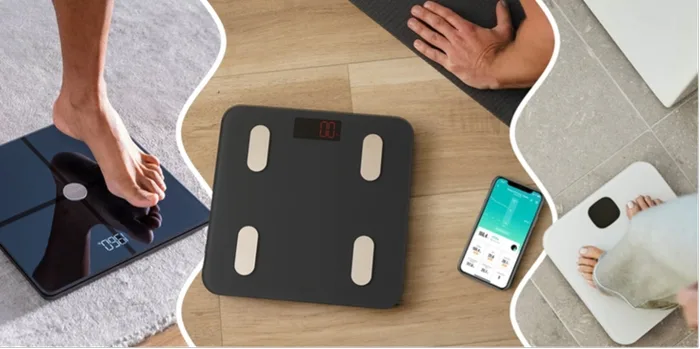
What Smart Scales Get Right And Wrong
By Sherami Tsai
For many of us, stepping on a bathroom scale is a familiar ritual. We’re usually hoping for a lower number—or at least not a higher one. However, the measure of pounds alone reflects little about what’s happening inside our bodies. It reveals nothing about how much of us is fat, muscle, or bone, or where our weight is carried.
Smart scales have exploded in popularity in recent years, as they promise to give us more insights. Unlike traditional scales, they claim to measure body fat, muscle mass, bone density, and even water levels for a more complete picture of health—with just a quick step.
Experts say smart scales can be useful for spotting trends, but caution that body composition is much more difficult to measure than most people realize. Despite their high-tech appeal, even the smartest devices have their limits.
What Smart Scales Promise to Measure
At first glance, smart scales seem like a simple upgrade to the bathroom scale. Most use bioelectrical impedance analysis (BIA), which sends a mild electrical current through the body. Because fat, muscle, and water conduct electricity differently, the scale estimates body composition based on how much resistance it encounters.
It’s the same principle as used in some medical offices, only now bundled into devices that connect with smartphone apps, track daily trends, and even share data with coaches or clinicians.
Some models boast advanced features like multi-frequency BIA or octopolar sensors, which claim to separately analyze the arms, legs, and trunk for greater accuracy.
The idea is compelling: instant, personalized insight into your internal health metrics without ever leaving your bathroom. However, experts caution that while these devices can be useful, measuring body composition accurately is far more difficult than stepping on a scale.
“There are a wide variety of commercial BIA devices available to the public today, and they range from great to terrible depending on what product you choose,” Clifton Holmes, a postdoctoral research fellow at the Arkansas Children’s Nutrition Center, told the Epoch Times in an email.
Why Measuring the Body Is so Tricky
Measuring body composition isn’t just about fat versus muscle—it’s about understanding where fat is stored and how those tissues affect our health. Visceral fat, for instance, wraps around internal organs and poses a much greater health risk than subcutaneous fat under the skin.
Measuring body composition is far more insightful than relying on Body Mass Index (BMI), the conventional formula that divides weight by height squared. Used for decades as a quick health screening tool, BMI often misses crucial details about what makes up a body and where fat is stored.
“BMI works well at the population level,” Susan Racette, a professor at Arizona State University, wrote to The Epoch Times in an email. “But it’s less informative at the individual level because it doesn’t distinguish between muscle and fat mass.”
A fit soldier and a sedentary office worker might share the same BMI but have drastically different health profiles. That’s why body composition analysis, not just weight or BMI, is increasingly recognized as a better metric of health.
“These types of assessments provide a much more accurate depiction of muscle growth or fat loss during any kind of lifestyle changes,” Holmes said.
Understanding body composition becomes even more important with age. Muscle mass declines by about 3 to 8 percent per decade after age 30, accelerating after 60. Left unchecked, this hidden shift can raise the risk of osteoporosis, sarcopenia, insulin resistance, and falls.
“Patients may not realize that not all weight loss represents fat loss,“ wrote Dr. Steven Heymsfield, a leading researcher in body composition, to the Epoch Times. ”Strength training and emerging drugs can shift the composition of weight loss to more fat and less muscle.”
What the Research Really Says
Even with advanced features, research shows that many smart scales miss the clinical gold standard by a wide margin.
In a 2023 study published in the British Journal of Nutrition, researchers evaluated 15 commercially available BIA devices against the gold standard four-compartment model, a lab method combining dual-energy X-ray absorptiometry (DEXA) scans, air displacement pods, and bioimpedance spectroscopy.
The results were mixed. Some scales came close to the clinical standard. Others missed badly, overestimating or underestimating body fat by as much as 11 percent. Nearly 40 percent of devices systematically overestimated fat in lean individuals and underestimated it in heavier ones—a pattern known as negative proportional bias.
Design mattered more than price: devices with both hand and foot sensors (octopolar models) generally outperformed simple foot-to-foot scales. Still, no consumer-grade scale was consistently precise.
“Some products clearly performed much better than others,” wrote Grant Tinsley, the study’s lead author and a professor at Texas Tech University. “But even the top-ranked devices demonstrated enough error that you should still be cautious when interpreting the results of an individual test.”
Among the most accurate for long-term tracking are the Omron HBF-516, Tanita BC-568 InnerScan, and Tanita UM-081.
A separate 2021 study published in JMIR mHealth and uHealth echoed these findings. While smart scales reliably tracked weight, estimates of fat mass and muscle mass often varied by up to nine pounds compared to DEXA scans.
“These devices are unregulated, and I’ve seen a wide range of accuracies,” said Heymsfield. For those serious about tracking health changes, he recommends using smart scales alongside other metrics like waist circumference, fitness performance, or periodic clinical assessments.
Where Smart Scales Can Still Help
Despite their flaws, experts say smart scales can still offer meaningful value, especially for spotting trends over time.
Unlike clinical tests, smart scales make it easy to track progress over time. As long as users weigh themselves under the same conditions, ideally, first thing in the morning, fasted, and after using the restroom. Trends can be meaningful, even if the exact body fat percentage isn’t.
“Tracking your weight on a daily or near daily basis, then averaging it for the week, is a great way to monitor whether you are gaining, losing, or maintaining during any kind of exercise program or new diet,” said Holmes.
Even small daily fluctuations, experts note, are normal. What’s important is the longer-term trend.
“I personally like to weigh myself daily and keep track of the weights,” said Heymsfield. “I see it vary from day to day, but over time it is very stable.”
Smart scales also help reinforce healthy habits. Some studies suggest that frequent self-weighing is linked to better weight loss and maintenance outcomes. Digital tracking apps, goal-setting features, and automatic data uploads can make it easier to stay accountable.
“Many devices do provide results that are accurate enough for many individuals to monitor their progress over time,” said Racette.
Still, experts urge users to keep perspective.
“If you are using any body fat scale, it would be best to consider the results alongside other metrics,” said Tinsley. “I would not use an at-home body fat scale as your only way of quantifying how your body is changing.”
Other Ways to Track Body Composition
For those looking beyond smart scales, clinical-grade tools offer deeper insights, though they come with trade-offs in cost and convenience.
DEXA remains the gold standard for body composition analysis. Originally developed to assess bone density, DEXA uses low-dose X-rays to separately measure fat, muscle, and bone. Scans take about 10 to 20 minutes and expose patients to less radiation than a day in the sun. However, DEXA may not always distinguish between visceral and subcutaneous fat, and costs vary.
Air displacement plethysmography, better known as the Bod Pod, estimates body fat by measuring how much air a person displaces in a sealed chamber. It’s quick, radiation-free, and popular among athletes and wellness centers. However, a 2015 study published in PLOS One found that Bod Pod measurements overestimated fat in very lean people and underestimated it in heavier ones.
At the highest end, CT and MRI scans provide detailed images of visceral fat and muscle quality, but they are expensive, time-consuming, and generally reserved for research or clinical diagnoses.
For those without access to these technologies, simpler at-home methods still have value. Skinfold calipers, which pinch the fat at specific body sites, and tape measures to track waist and hip circumference, offer valuable insights when used consistently over time. Heymsfield also pointed to newer smartphone-based 3D imaging apps, such as Methreesixty, as promising additions.
“The goal is not necessarily to find the perfect tool,” said Holmes, “but to track meaningful change over time and to make informed adjustments along the way.”
Consistency Matters
The rise of smart scales reflects something deeper: a hunger for more meaningful ways to understand our bodies beyond just a single number on a scale.
Body composition offers a fuller window into health, risk, and resilience. No device, however smart, can capture that perfectly. But with consistent use, realistic expectations, and broader context, smart scales can serve as useful companions in a much bigger picture.
“Assessing one’s body composition is an excellent way to track a person’s progress during any kind of physical activity or dietary changes,” said Holmes. “Even though incorporating body composition measures into regular clinical visits will cost time and money, it is well worth it with all the benefits and information it provides.”
Ultimately, the best tool is the one you can use consistently, as part of a lifelong journey. “Maintaining proper health and fitness is not a quick sprint to the finish line,” Holmes said. “It is a lifelong journey.”


